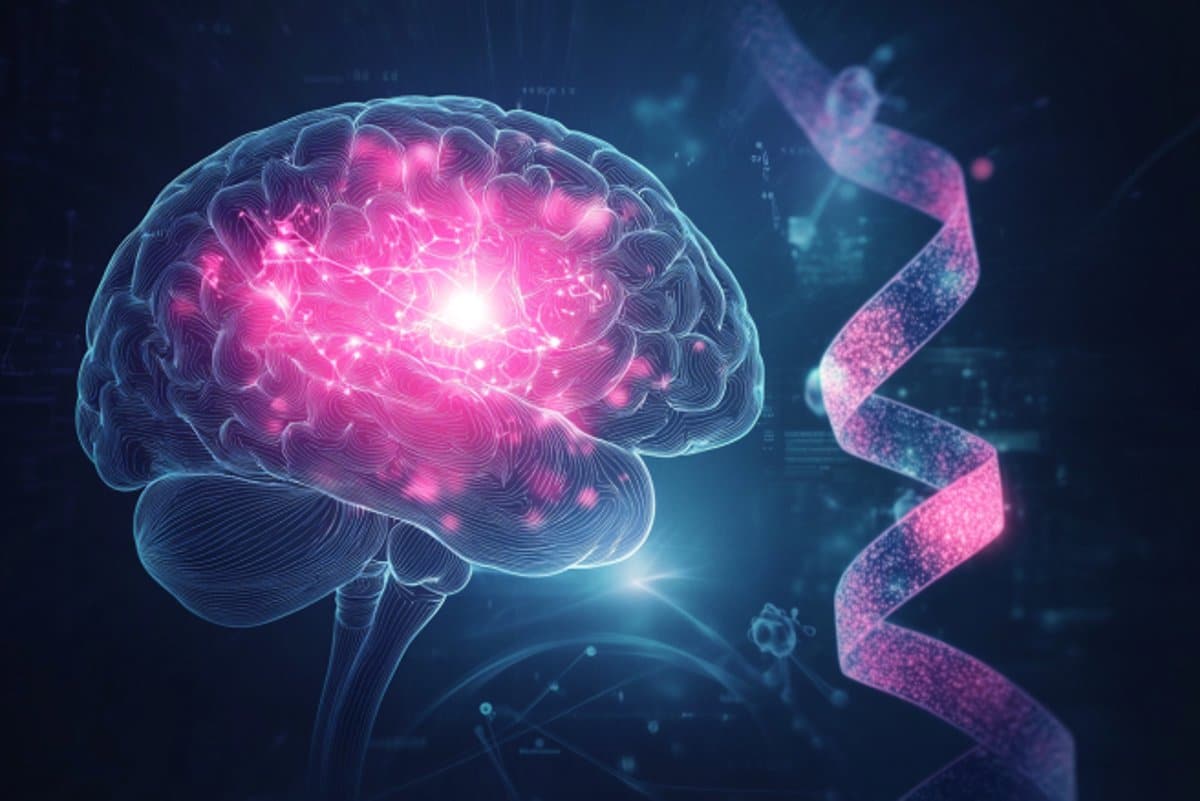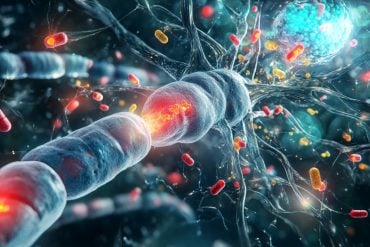Summary: New research shows that apathy and fatigue in advanced cancer are driven not by physical decline, but by inflammation-sensing neurons that suppress motivation. Scientists discovered that inflammation triggers a brainstem-to-reward-center pathway that reduces dopamine, the brain’s key motivation chemical.
Blocking this pathway in mice restored their drive to act, even in late-stage cancer, despite ongoing weight loss and disease progression. The findings point to a potential new way to improve quality of life in patients by targeting brain inflammation directly.
Key Facts:
- New Brain Pathway Identified: Inflammation-sensing neurons in the brainstem suppress dopamine release, reducing motivation in cancer.
- Treatment Potential: Blocking these neurons or using an IL-6 antibody restored motivation in mice with advanced cancer.
- Broader Impact: The same pathway may underlie apathy across other chronic inflammatory illnesses.
Source: WUSTL
The fatigue and lack of motivation that many cancer patients experience near the end of life have been seen as the unavoidable consequences of their declining physical health and extreme weight loss.
But new research from Washington University School of Medicine in St. Louis challenges that long-held assumption, showing instead that these behavioral changes stem from specific inflammation-sensing neurons in the brain.

In a study published April 11 in Science, the researchers report that they identified a direct connection between cancer-related inflammation and the loss of motivation characteristic of advanced cancer.
Studying mice with cancer-linked cachexia, a condition typical of the disease that leads to muscle wasting and weight loss, they discovered a previously unrecognized pathway in the brain. This pathway senses inflammation and actively suppresses dopamine — a key driver of motivation — resulting in apathy and loss of drive.
Blocking the pathway restored motivation, even though the cancer and weight loss continued. This indicates that apathy can be treated separately from the disease itself.
“The implications of the research are profound,” said the study’s lead author, Adam Kepecs, PhD, professor of neuroscience and of psychiatry at WashU Medicine.
“We’ve uncovered a direct brain mechanism through which inflammation drives apathy in cancer, and we were able to restore normal motivation in mice with cachexia, despite ongoing inflammation as cancer progressed.”
About 70% of patients with advanced cancer experience cachexia. In addition to physical decline, patients often suffer from severe fatigue, apathy and a lack of motivation that affect their overall quality of life.
To understand whether these psychological symptoms are side effects that emerge from physical deterioration or whether they arise from distinct biological mechanisms, the research team, including Marco Pignatelli, MD, an assistant professor of psychiatry at WashU Medicine, and Tobias Janowitz, MD, PhD, an associate professor at Cold Spring Harbor Laboratory, turned to a well-validated mouse model of cancer cachexia.
They focused specifically on behavioral symptoms, which had not previously been investigated, and mapped the brain regions involved.
They discovered that a structure in the brainstem, a part of the brain that controls vital functions such as breathing and heart rate, acts as a sensor for inflammatory signals in the bloodstream, particularly a molecule called interleukin-6 (IL-6), which is elevated in cancer cachexia.
When IL-6 levels rise, neurons in this region of the brainstem transmit a signal through a defined pathway that suppresses dopamine release in a part of the brain called the nucleus accumbens, which is key for motivation and reward.
The resulting drop in dopamine had the effect of making the mice less motivated to exert themselves to complete activities.
To see if interfering with this response could treat the lack of motivation and apathy, Kepecs and his colleagues tried two different approaches: they boosted dopamine levels and blocked inflammation-sensing neurons in the brainstem. Both approaches eliminated or reduced apathy in the mice.
Treating the mice with an IL-6 antibody similar to an existing FDA-approved drug for rheumatoid arthritis, an inflammatory condition, also restored the animal’s motivation, a finding that points to a potential treatment for the psychological symptoms associated with advanced cancer.
“What’s remarkable is that motivation was restored even in late-stage disease,” said Pignatelli. “It suggests we may be able to improve quality of life by targeting the brain circuit.”
For acute illnesses such as infections, this inflammation-driven reduction in motivation may be adaptive, helping the body conserve energy to fight off disease, Kepecs explained.
But in chronic conditions such as cachexia, prolonged apathy — including a reduced drive to eat, move or engage socially – can become harmful, worsening health and quality of life.
Because IL-6 — the inflammatory molecule driving this effect — is elevated in many other conditions, and the brain regions involved are central to motivation, this same circuit likely contributes to apathy across a range of chronic illnesses.
“This gives us a new way to understand apathy in advanced cancer,” said Kepecs. “It’s not just a byproduct of physical decline, but a direct response to inflammation in the brain.
“That means we can potentially target the underlying biology to improve motivation and quality of life — even when the cancer itself is no longer treatable.”
Funding: This research was funded by the National Institute of Child Health and Human Development of the National Institutes of Health (NIH) grant P50 HD103525, Deutsche Forschungsgemeinschaft grant DFG -STA 1544, LaCaixa, the Mark Foundation for Cancer Research grant 20-028-EDV, the Simons Foundation, Cancer Grand Challenges, NIH grant 1OT2CA278690-01, CRUK: CGCATF-2021/ 100019, and NIH/National Cancer Institute grant R37CA286477-01A1, Cancer Center Support grant 5P30CA045508, NIMH grant MH130610, the Taylor Family Institute for Innovative Psychiatric Research, the Hope Center Pilot Grant, the McDonnell Center for Systems Neuroscience Small Grant, and the NARSAD Young Investigator Grant 27102 and P&S Fund, a WUSTL BJC investigator award and NIH grant DP1 MH14002.
The content is solely the responsibility of the authors and does not necessarily represent the official views of the NIH.
About this Cancer and neurology research news
Author: Jessica Church
Source: WUSTL
Contact: Jessica Church – WUSTL
Image: The image is credited to Neuroscience News
Original Research: Closed access.
“A neuroimmune circuit mediates cancer cachexia-associated apathy” by Adam Kepecs et al. Science
Abstract
A neuroimmune circuit mediates cancer cachexia-associated apathy
INTRODUCTION
Cachexia is a debilitating wasting syndrome that affects most advanced cancer patients, characterized by profound involuntary weight loss, muscle and fat depletion, and disrupted energy balance. Beyond physical decline, patients commonly experience severe fatigue, apathy, and depression that further diminish their quality of life.
Despite these pervasive neuropsychiatric symptoms, the biological mechanisms linking peripheral wasting to brain dysfunction and behavioral changes remain poorly understood, hindering the development of effective treatments.
RATIONALE
Systemic inflammation, marked by elevated circulating cytokines, is a key driver of cancer cachexia. Although inflammation could broadly compromise neuronal function, we hypothesized that it acts through specialized circuits that conserve energy during acute illness.
In cancer, persistent activation of these circuits may drive chronic fatigue and depression, providing a mechanistic framework for how inflammation dynamically regulates motivation.
RESULTS
To investigate cachexia’s impact on motivation, we used an established preclinical model: mice subcutaneously implanted with colon adenocarcinoma cells (C26). Within weeks, the mice exhibited classical cachexia symptoms—weight loss, muscle wasting, and decreased feeding—accompanied by pronounced motivational deficits.
A battery of behavioral assays uncovered specific deficits in effort-sensitive tasks such as patch foraging and progressive ratio tests. By contrast, tests of physical activity (open-field exploration), reward sensitivity (sucrose preference, a measure of anhedonia), and despair (tail suspension, forced swim tests) remained unchanged, although home-cage activity was reduced.
This identifies a specific reduction in effort-based motivation, indicative of apathy and distinct from general weakness or anhedonia.
A comprehensive cytokine screen showed rising interleukin-6 (IL-6) levels in the blood and brain that paralleled cachexia progression. Whole-brain, cellular-resolution activity mapping and viral tracing uncovered a circuit originating in the area postrema, a circumventricular organ specialized for detecting blood-borne signals.
IL-6–sensing neurons in this region project to the parabrachial nucleus, which in turn activates the substantia nigra pars reticulata inhibitory neurons, ultimately suppressing dopamine release in the nucleus accumbens. Optogenetic stimulation of area postrema neurons rapidly suppressed accumbens dopamine release.
Longitudinal dopamine monitoring during cachexia progression revealed a progressive decline in accumbens dopamine that tracked with worsening motivational deficits.
Targeting this IL-6–sensing pathway reversed cachexia-induced apathy. Blocking IL-6 with systemic antibodies, knocking down (genetic reduction of gene expression) IL-6 receptors in the area postrema, or ablating area postrema–to–parabrachial neurons each alleviated the motivational deficits.
Conversely, boosting dopamine signaling in the nucleus accumbens—through optogenetic stimulation of dopamine neurons or local dopamine agonist infusion—restored motivation despite ongoing inflammation, even at late stages of cancer progression.
CONCLUSION
We identified an immune-to-neural circuit through which inflammation drives motivational deficits in cancer cachexia. Area postrema neurons detect circulating IL-6 and relay this signal to the basal ganglia to suppress mesolimbic dopamine, thereby increasing effort sensitivity.
This specialized interoceptive pathway demonstrates that inflammation engages discrete neural circuits rather than causing broad disruption and cumulative neural damage.
Although this circuit is likely adaptive during acute illness—conserving energy by dampening motivation—its persistent engagement in chronic conditions such as cancer cachexia is detrimental.
This reveals that psychiatric symptoms such as apathy in cachexia are not secondary effects of physical decline but can arise directly from the same pathological mechanisms driving the illness itself.
Targeting this circuit through ablation of IL-6 sensing or boosting dopamine release relieved motivational deficits, opening therapeutic avenues for neuropsychiatric symptoms in cachexia and possibly other inflammatory conditions where IL-6 is elevated.
Moreover, by quantifying effort sensitivity as a dimension of motivation that is measurable across species establishes that inflammation specifically drives apathy-like behavior, enabling clinical translation and treatments for inflammation-driven motivational deficits common to conditions ranging from cancer to depression.






